SATA is one of the primary interfaces for installing storage drives. In some instances, the version of the SATA interface does matter when installing a drive (particularly with SATA SSDs). In this write-up, I will discuss identifying SATA 1 2 3 versions on your motherboard and hard drive.
There are three ways to identify the SATA version of your motherboard or the hard drive. You can check its spec sheet; for this method, you need to know the make and model of the motherboard and the hard drive.
Alternatively, you can perform a physical inspection of the components. Finally, you can identify the SATA version using third-party software.
I will talk about these methods in depth below. At the same time, I will speak briefly on the SATA interface, the terminology used in identifying the different SATA versions, and why the SATA version matters.
TABLE OF CONTENTS
What is the SATA Interface in Brief?
SATA, or Serial ATA, is one of two primary interfaces (the other one being PCIe) for adding essential components to your PC.
While PCIe is used for various high-speed devices, the SATA interface is used mainly for adding storage devices which include:
- Hard Disk Drives
- SATA Solid State Drives
- Optical Drives, i.e., CD/DVD/Blu-Ray Drives
SATA ports can easily be identified on any given motherboard. A typical motherboard can easily feature between 4-6 SATA Ports.
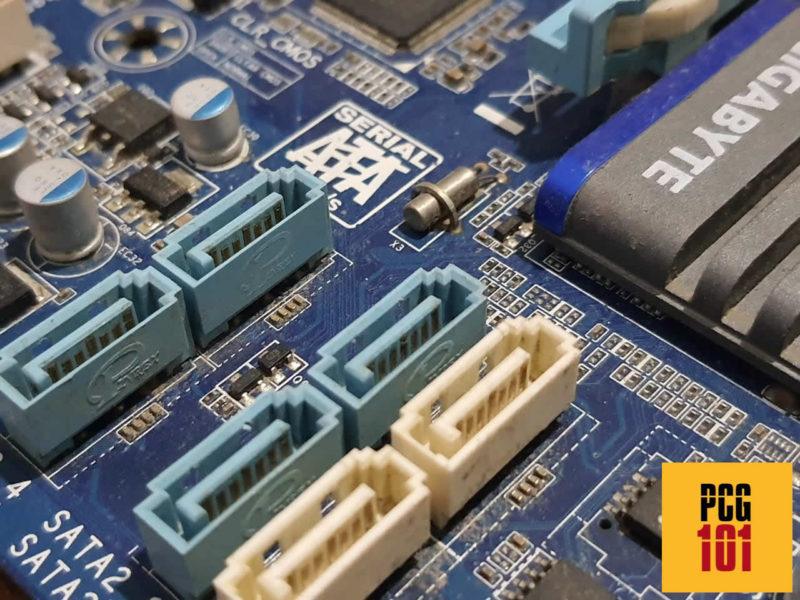
Also Read: What Does SATA Cable Look Like?
SATA Versions and Nomenclature Used in Identifying Different SATA Versions
SATA has different versions. The latest SATA version is 3. The SATA interface doubles its throughput rate (transfer speed) with each newer version. As such:
- SATA 1 has a throughput rate of 1.5 Gbps or 187.5 MB/s
- SATA 2 has a throughput rate of 3.0 Gbps or 375 MB/s.
- SATA 3 has a throughput rate of 6.0 Gbps or 750 MB/s.
It should be noted, however, that different spec sheets use different naming conventions for SATA interface such that:
- SATA 1 can be labeled as SATA 1.5G, SATA 1.5 Gbps, or SATA 150
- SATA 2 can be labeled as SATA 3G, SATA 3 Gbps, or SATA 300
- SATA 3 can be labeled as SATA 6G, SATA 6 Gbps, or SATA 600
Also, Gbps (Gigabits per second) is NOT the same as the GB/s (Giga Byte per second). There are 8 bits in a byte. Hence 6 Gbps = 0.75 GB/s.
Also Read: Is SATA 3 Compatible with SATA 2 Ports?
How to Identify SATA 1 2 3 on Your Motherboard?
With the basics of SATA and its versions in mind, please identify what SATA version your motherboard meets.
There are three easy ways to identify this:
- Physically Reading the Labels on the Motherboard
- Checking Out the Specsheet of the Motherboard
- Using Third-Party Software
1. Physically Reading the Labels on the Motherboard
If you are on a desktop, one of the easiest ways to physically identify your ports’ SATA version is to check their labels.
The SATA ports are clearly labeled on most motherboards with their version and system identification number.
First, please identify where the SATA ports are located. Again, they look like L shape connectors often found in a cluster.
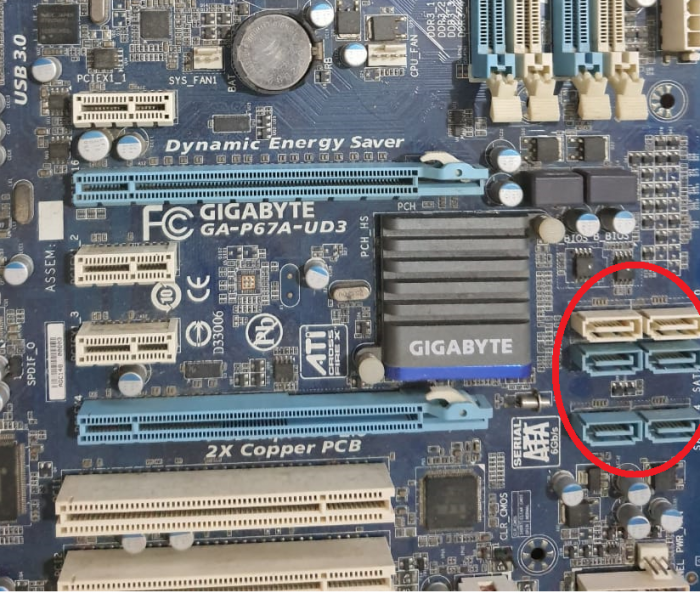
Next, read what their labels indicate:
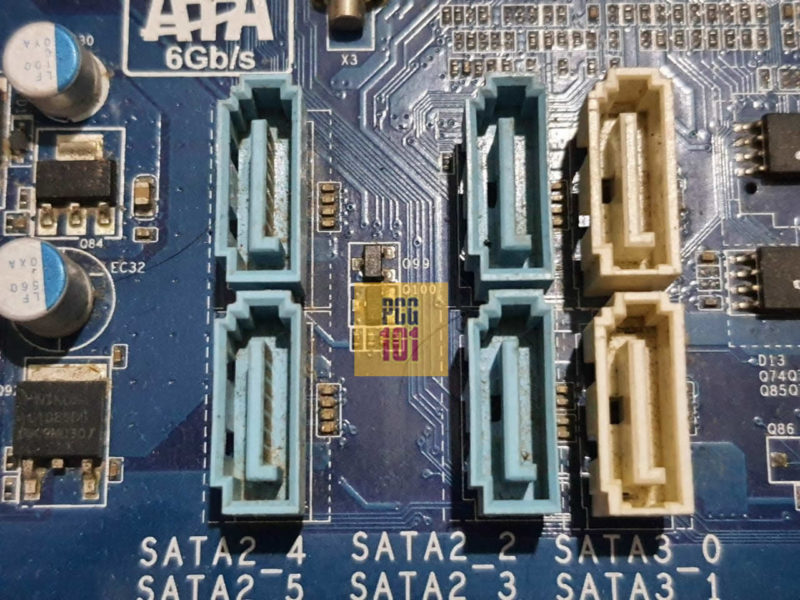
Here you can see that there are two sets of SATA ports identified by their color code as well as by their labels.
- Blue SATA Ports: correspond to SATA 2. Their labels have “SATA2” clearly highlighted.
- White SATA Ports: correspond to SATA 3. Their labels have “SATA3” clearly highlighted.
So, this motherboard has 4 x SATA 2 ports and 2 x SATA 3 ports. Ideally, I would first occupy the SATA 3 slots due to their faster transfer rates.
However, this method of identifying the SATA version may not be feasible for laptops as they are more difficult to disassemble than desktops.
SATA Ports Can Conform to Different SATA Versions on The Same Motherboards
One characteristic seen on the motherboard shown above is that you can find SATA ports conforming to the different versions on the same motherboard, mainly if it is old.
In this case, the motherboards will have color-coded ports to highlight which version each conforms to.
2. Checking Out the Specsheet of the Motherboard
If you know the make and model of your motherboard, then it should be pretty simple to identify what version of the SATA your board conforms to.

Here you can see that the motherboard offers:
- 2 x SATA 6 Gb/s (SATA 3 connectors)
- 4 x SATA 3 Gb/s (SATA 2 connectors)
As simple as that.
3. Using Third Party Software
The last and another relatively simple method is to use third-party software.
This method is excellent if you are on a laptop and need to know your motherboard’s model number.
There are two popular free third-party software options that I recommend:
Identifying Using Crystal Disk Info
Once you have downloaded and installed Cyrstal Disk Info, Run it, which should open a Window similar to the one shown below:
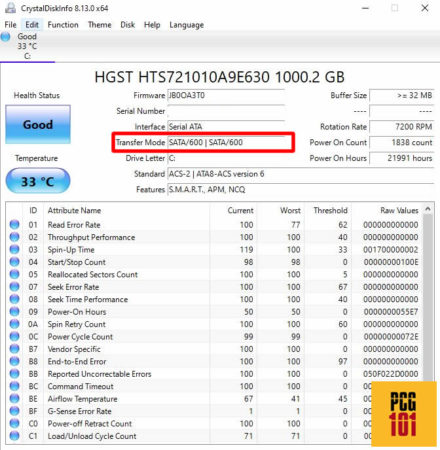
While the software shows beneficial details regarding your hard disk, including its make, model, and specs, we are interested in the field labeled “Transfer Mode.”
Here you can see that the transfer mode for my single disk is SATA 600, which is just another name for SATA 3.
Hence, this helps confirm that my PC’s SATA interface conforms to version 3.0.
Identifying Using HWInfo
Another popular software that can help you identify not just the SATA version of your board but also give you comprehensive details regarding your PC hardware is HWInfo.
Once you have downloaded the software, run it, which should open a few Windows, including one similar to the Window shown below:
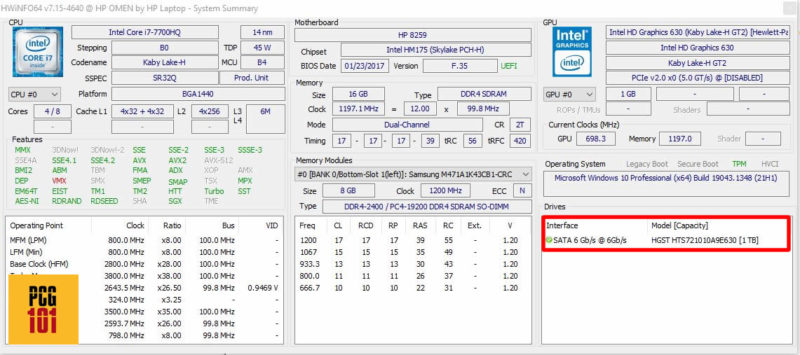
Look for the section labeled “Drives” and then for the field marked “Interface.” This should help you identify the version of your SATA interface.
Mine reads SATA 6 Gb/s, which is another name for SATA 3.
Again, using third-party software is best if you want to determine whether your motherboard supports SATA 3 but want to go with the least invasive method.
A Typical Spinning Hard Drive DOES NOT Saturate the SATA 3 Interface.
Just because the SATA 3 interface works at 6 Gbps (750 MB/s) Does Not mean that the connected hard disk drive will also have a transfer speed of 750 MB/s!
At best, a typical hard disk drive has a max transfer rate of 200 MB/s. A standard hard disk drive can barely saturate the SATA 2 interface, let alone the SATA 3 interface.
How to Identify THE SATA Version of Your Hard Drive?
Other than reading the spec sheet, the best way, and my recommended method, to check the SATA version of your Hard Drive is to use the popular free software HWInfo that I talked about earlier.
With the software installed, could you run it? The software would open a few Windows, including one similar to the Window shown below:
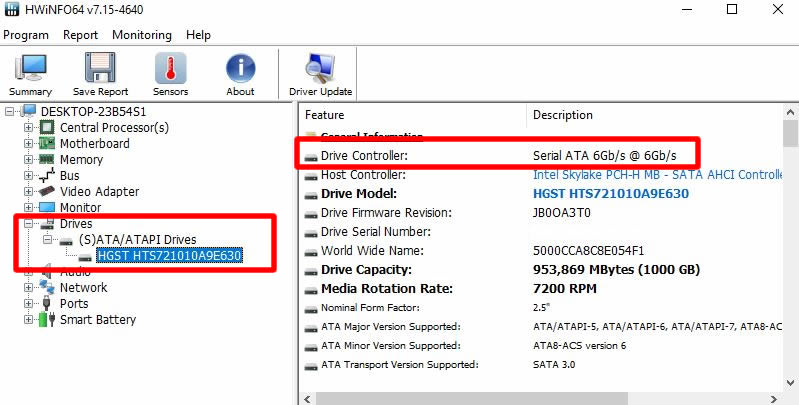
On the Left Hand Menu, navigate to Drives -> SATA/ATAPI Drives -> Select Your Drive.
You will have more drives to work from if you have multiple. I only have one drive installed; hence it only shows a single drive in the drop-down menu on the left.
Once the Drive is selected, you should see its corresponding details on the Right-Hand side, including the Controller the Drive uses.
The “Drive Controller” description would identify the SATA version of the Drive. The explanation for my drive reads Serial ATA 6Gbps, the same as SATA 3.
Again, as mentioned earlier, just because the drive has a SATA 3 controller and connects to a SATA 3 port DOES NOT mean that it would operate at a transfer speed of 750 MB/s!
Also Read: Can You Use a Laptop Hard Drive on a Desktop?
When Does the Version of the SATA Port Matter?
The only time the version of the SATA interface can significantly matter for a commercial PC is when installing a SATA SSD.
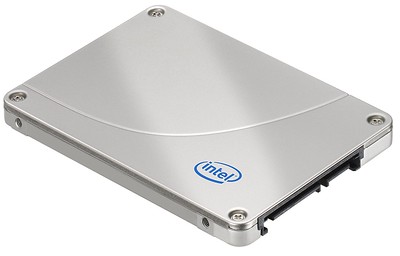
A SATA 3 SSD, for instance, MUST go into a SATA 3 port to provide the best performance.
A SATA 3 SSD has a typical transfer rate of 550 MB/s. If you install this in a SATA 2 port, its transfer speed will be halved!
I have already explained this topic in detail: Does it Matter Which SATA Ports You Use?
Also Read:
Final Words
In short, several ways to identify SATA 1 2 3 on your system exist. For instance, if you have just recently bought a computer (a brand new one), then there is a high chance that it will have SATA 3 ports.
Unless you want to install SATA SSDs, it matters little whether you connect your hard disk drive, or the optical drive, to SATA 2 or SATA 3 ports.
Unfortunately, with NVMe (PCIe-based) SSDs operating at multiple folds faster transfer rate than SATA SSDs, the SATA SSDs have lost their purpose and need a quicker SATA interface.
FREQUENTLY ASKED QUESTIONS
1. Can I connect a SATA 3 drive to a motherboard that only supports SATA 1 or 2?
Yes, you can connect a SATA 3 drive to a motherboard that supports SATA 1 or 2. However, the maximum transfer rate will be limited to the maximum transfer rate of the SATA version supported by the motherboard.
2. Is there any performance advantage to using a SATA 3 drive on a motherboard that only supports SATA 1 or 2?
No, there is no performance advantage to using a SATA 3 drive on a motherboard that only supports SATA 1 or 2. The maximum transfer rate will be limited to the maximum transfer rate of the SATA version supported by the motherboard.
3. Can I use a SATA 3 cable with a SATA 1 or 2 drive?
Yes, you can use a SATA 3 cable with a SATA 1 or 2 drive. SATA 3 cables are backward compatible with SATA 1 and 2 drives. However, the maximum transfer rate will be limited to the maximum transfer rate of the SATA version supported by the drive and the motherboard.

Thank you for this informative and easy to understand explanation. I was able to easily identify my sata ports as SATA3